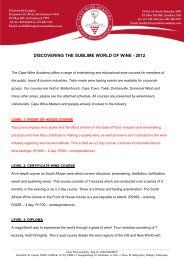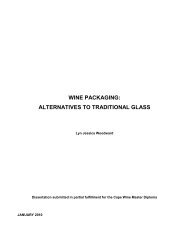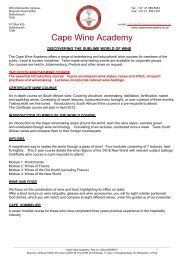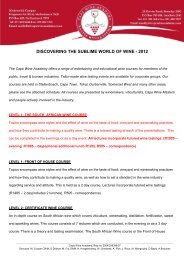micro-oxygenation in contemporary winemaking - Cape Wine ...
micro-oxygenation in contemporary winemaking - Cape Wine ...
micro-oxygenation in contemporary winemaking - Cape Wine ...
You also want an ePaper? Increase the reach of your titles
YUMPU automatically turns print PDFs into web optimized ePapers that Google loves.
Micro-<strong>oxygenation</strong> <strong>in</strong> Contemporary W<strong>in</strong>emak<strong>in</strong>gCHAPTER 6: UNDERLYING CHEMISTRY OF MICRO-OXYGENATIONPart III of this report seeks to review the available scientific evidence related to the topic of<strong>micro</strong>-<strong>oxygenation</strong>. Chapter 7 will summarise the f<strong>in</strong>d<strong>in</strong>gs of those studies that haveevaluated the impact of <strong>micro</strong>-<strong>oxygenation</strong> directly. However, <strong>in</strong> the absence of conclusiveevidence from such studies, much of the justification and support for <strong>micro</strong>-<strong>oxygenation</strong> isderived from the more general research on phenolic reactions dur<strong>in</strong>g w<strong>in</strong>emak<strong>in</strong>g andage<strong>in</strong>g. That area of research is the topic of Chapter 6.The first section of this Chapter <strong>in</strong>troduces the important phenolic constituents of w<strong>in</strong>ewhile the second section will describe some of the phenolic reactions that have beenshown to be important dur<strong>in</strong>g w<strong>in</strong>emak<strong>in</strong>g and age<strong>in</strong>g.6.1 IMPORTANT PHENOLIC COMPOUNDS IN GRAPES AND WINE6.1.1 Importance of Phenolic Compounds <strong>in</strong> W<strong>in</strong>eThe phenolic compounds are one of the most important constituents of w<strong>in</strong>e, both <strong>in</strong> termsof their high concentration <strong>in</strong> w<strong>in</strong>e, and also because of the key role that they play <strong>in</strong>determ<strong>in</strong><strong>in</strong>g the organoleptic properties of w<strong>in</strong>e (Ribéreau-Gayon and Glories, 1987;Cheynier et al., 1997; Kennedy et al., 2006; Ribéreau-Gayon et al., 2006c). W<strong>in</strong>e phenols<strong>in</strong>clude the anthocyan<strong>in</strong>s and tann<strong>in</strong>s and it is these compounds that are responsible forthe colour, structure and mouthfeel of w<strong>in</strong>es (Jones et al., 1999; Monagas et al., 2005;Cheynier et al., 2006; Parker et al., 2007).It is also the reactions of phenolic compounds that determ<strong>in</strong>e the development of w<strong>in</strong>edur<strong>in</strong>g maturation and age<strong>in</strong>g (Cheynier, 2002; Fulcrand et al., 2006; Ribéreau-Gayon etal., 2006a). Polymerisation of monomers as well as condensation reactions betweendifferent phenolic compounds produce the characteristic changes associated with age<strong>in</strong>g:young bright red w<strong>in</strong>es turn red-orange, and harsh young tann<strong>in</strong>s become softer and lessastr<strong>in</strong>gent.More recently, it has been identified that it is the anti-oxidant properties of phenoliccompounds that are responsible for most of the beneficial health effects of w<strong>in</strong>e (Manzoccoet al., 1999; de Beer et al., 2002). By remov<strong>in</strong>g toxic Reactive Oxygen Species (oxygen34
















